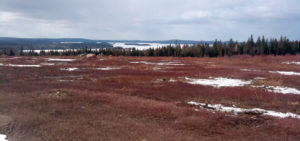First Spring Look: Maine’s Wild Blueberry Barrens
Spring is officially here, and for fields being prepared for the wild blueberry harvest, that means the first show of growth which evolves into the astonishing blue blooms that cover the land in late summer.
Maine and Eastern Canada is exclusive territory for wild blueberries. Over 60,000 acres of blueberry farmland stretch across Maine alone, providing an average 70 million pounds of berries each year. Native to these weather-challenged regions, wild blueberries are naturally resilient. They have evolved to grow in acidic soil, thrive through wildly changing temperatures, and use their natural UV protection to survive unshielded in summer sun.
Each wild blueberry crop is the result of a two-year cycle of variable and unpredictable conditions. Crop development is dependent upon the first season’s spring and summer, the extent of potentially injurious frost, the amount of winter snow that provides protection, as well as the next year’s spring and summer weather. Abundant snow is an advantage for wild blueberry production, and this year was a windfall. Snow, in addition to providing protection to the plant, provides plenty of moisture which can increase the size of the bud and the potential to have more fruit per plant.
The plant’s heartiness is all part of the mystique of this fabulous fruit: the result is a naturally healthy antioxidant-rich berry with a distinctive taste and variations in color that can’t quite compare to its cultivated counterparts in other parts of the world.
late summer turns the fields blue.
These fields would not have seen much activity over the winter months. Growers usually spend little time on the barrens during the winter unless they are engaged in expanding fields or posting farm land to ensure protection from snowmobiles. Families that farm wild blueberry fields would have been doing seasonal winter work or working in other businesses. Some would likely have been engaged in off-season education in an effort to maintain knowledge of farming techniques and regulations, or traveling to farm shows in search of equipment and supplies or to purchase bees.
While these “first looks” at the spring barrens show them sporting some winter baggage, they will soon come to life and present green leaves and delicate white-pink blossoms. Those blossoms will gradually turn their eponymous blue in late July and early August before turning to a crimson red in the fall.
Here’s to a strong season for wild blueberry harvesters!
Read more about wild blueberry growing and harvesting.



